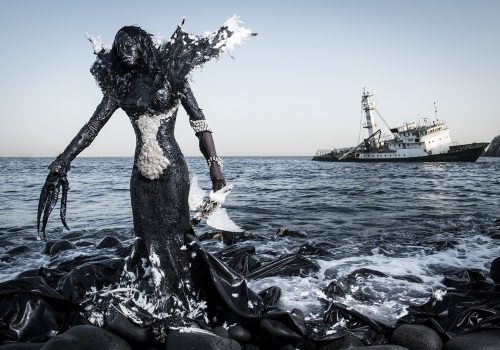Whether climate change or forest dieback, the waste crisis or sea pollution – art cannot close its eyes to the ecological challenges of the present.
The photographers have only interpreted the world, in various ways; the point,
however, is to change it, Marx wrote in 1845 in his Theses on Feuerbach. Whereby he actually spoke of “philosophers”; and it is well known that he debunked himself as a thinker who changed the world like no other. But photographers, too, interpret the world with every single glance and prepare the sediment for change.
For the world functions according to the laws of the image: What is not visible does not exist, and the more something is visible, the more it exists. Man- made climate change is a volatile example of this. While almost all scientific studies on the subject agree in their core statements, they remain abstract in their prognoses. They are conceivable, but they can only be photographed where they manifest themselves visibly – as floods, monster storms, or the melting of polar ice.
When images are lacking, science has a hard time. The climate change deniers claim, depending on their leaning, that there is no climate change at all; or if so, it is not man-made; or if it is perhaps man-made, it has no significant social or ecological consequences. The history of this denial is as old as the modern environmental movement itself, and it reaches threateningly into the political decision-making centers of today, where financially strong lobbyist groups obscure the view of scientific expertise.
So can photography, can art, deliver the images that help change the world? Yes, it can. It has done this in spectacular moments – think of the Vietnam War – and it does it incessantly as a whole. Art, according to Plato, can medi- ate between science and politics; and this role seems more indispensable
today than ever in view of the state of the world. This issue brings together examples of ecologically committed photography with a variety of different concepts and methods – from documentary research via allegorical staging to activist reportage. Some images seem frightening, even dystopic; but in all there is also the seed of hope. Because photography not only interprets the world, it can also ignite the forces to change it.
Andreas Müller-Pohle
European Photography 106: The Environmental Issue. Photography and the ecological challenges of the present, edited by Andreas Müller-Pohle. With David Maisel, Dillon Marsh, Henk Wildschut, Ian van Coller, Alicja Wróblews- ka, Fabrice Monteiro, Lucas Foglia, Daniel Beltrá, and Daniel Chatard. Also in this issue: Environmental Glossary | Planet Earth: A Matter of Life and Death
| Gardens of Horror | Photo Festivals around the World | Photo Encounters: From Athens to Białystok | Fred Baldwin: Dear Mr. Picasso – 80 pp., 24 x 30 cm, English/German. Single issue EUR 18.00, https://equivalence-shop.com
















